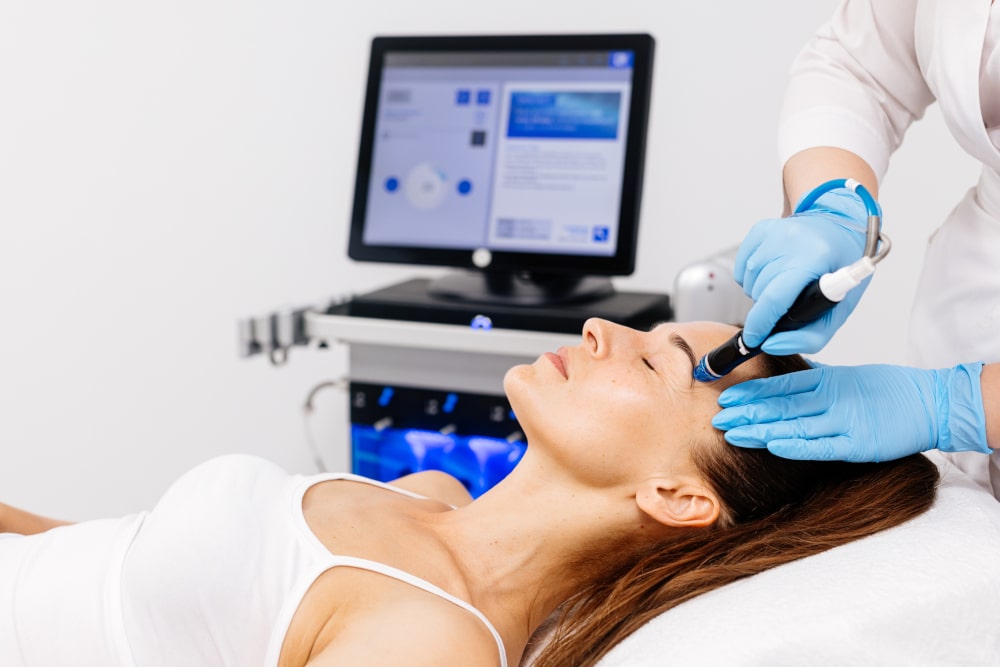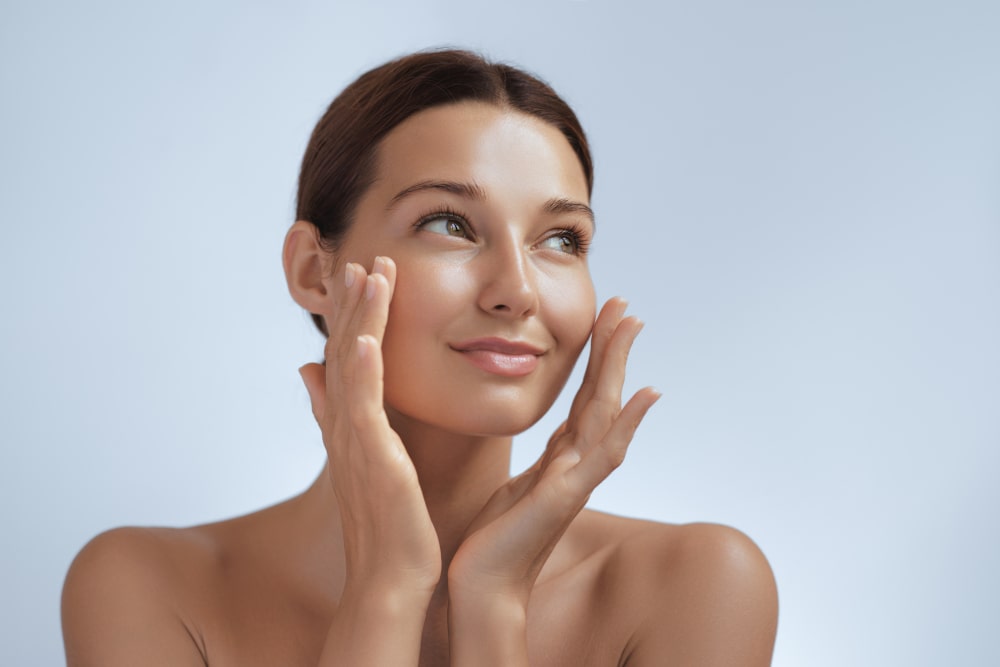Key Takeaways:
- Melasma, also known as the “mask of pregnancy,” is a common form of hyperpigmentation that affects mainly women, often triggered by hormonal changes and sun exposure.
- HydraFacial is a non-invasive, customizable facial treatment that can help address skin concerns like melasma and hyperpigmentation.
- The treatment works by exfoliating the skin, removing dead skin cells, and infusing serums that contain brightening and repairing ingredients such as Vitamin C and peptides.
- HydraFacial effectively improves skin tone and texture, making it a suitable option for those dealing with uneven pigmentation.
- The treatment is quick, with no downtime, and can be safely used on most skin types, including sensitive skin.

Melasma, or chloasma faciei, is a common skin condition characterized by dark, irregularly shaped brown or gray-brown pigment patches. While melasma can develop on any body area, it most commonly appears on the face, especially the forehead, cheeks, chin, and nose—regions often exposed to the sun. Although sun exposure is a significant trigger for melasma, hormonal changes are a primary cause of the condition. Women, particularly during pregnancy, or those taking birth control pills or undergoing hormone replacement therapy, are more prone to developing melasma. This has earned the condition the nickname “the mask of pregnancy.” Unfortunately, melasma can cause feelings of self-consciousness and may negatively impact a person’s confidence.
When addressing hyperpigmentation, such as melasma, many people wonder if HydraFacial helps with hyperpigmentation. The answer is yes. HydraFacial can be a valuable treatment option for individuals with this skin condition. HydraFacial is a non-invasive facial treatment that combines deep cleansing, exfoliation, extraction, hydration, and antioxidant protection. The treatment helps to brighten the skin and improve the appearance of various skin concerns, including hyperpigmentation, fine lines, and uneven skin tone.
Sharon R. Cassar, RN, MSN, FNP, (C):
HydraFacial is a fantastic option for individuals looking to improve skin tone and texture, especially those dealing with melasma and hyperpigmentation. The treatment’s ability to exfoliate and deliver nourishing serums directly to the skin provides immediate results and long-term benefits, making it a valuable tool in addressing these common skin concerns.
Is HydraFacial Good for Hyperpigmentation?
One of the most common questions asked individuals seeking solutions for hyperpigmentation is, is HydraFacial good for hyperpigmentation? Yes, it can be highly effective. HydraFacial uses a patented Vortex-Fusion® delivery system that infuses the skin with serums tailored to target hyperpigmentation. These serums contain potent ingredients like Vitamin C, peptides, and hyaluronic acid, which are known for their skin-brightening and skin-repairing properties. This treatment exfoliates the outer layers of the skin to remove dead skin cells and promote cell turnover, allowing healthier, more even-toned skin to emerge. HydraFacial offers a gentle yet practical approach for individuals dealing with melasma to fade dark spots and gradually restore a more balanced complexion.

Is HydraFacial Good?
For many people seeking a professional skincare treatment, the question remains: is HydraFacial good? Absolutely. HydraFacial provides a customizable treatment suitable for most skin types, including those with sensitive skin. The procedure is quick, non-invasive, and requires no downtime, making it a convenient option for those with busy lifestyles. Whether you’re looking to treat melasma hyperpigmentation or enhance your skin’s overall health and appearance, HydraFacial offers a proven solution that delivers noticeable results. HydraFacial treatments are generally safe and well-tolerated, with most patients experiencing immediate skin texture and brightness improvements after just one session.
If you’re looking for a way to manage melasma or other forms of hyperpigmentation, HydraFacial is a safe and effective treatment that can significantly improve the appearance of your skin over time. Always consult a licensed skincare professional to determine if HydraFacial is right for your skin concerns.
By incorporating key treatments like HydraFacial into your skincare routine, you can work towards achieving a more transparent, more radiant complexion free from the dark spots associated with melasma and other hyperpigmentation issues.
FAQ: HydraFacial and Melasma
Can HydraFacial be used as a primary treatment for melasma?
HydraFacial is an effective supportive treatment for melasma, but it works best when combined with other medical-grade skincare and sun protection. Since melasma is often triggered by hormonal changes, a comprehensive approach may be needed for long-term management.
How does HydraFacial differ from other hyperpigmentation treatments?
Unlike aggressive laser treatments or chemical peels, HydraFacial is a gentle, non-invasive procedure that provides immediate hydration and brightening without downtime. It’s suitable for most skin types and can be performed regularly without irritating the skin.
Are the results of HydraFacial for melasma permanent?
HydraFacial can significantly improve skin tone and texture, but melasma is a chronic condition that may reappear due to sun exposure or hormonal changes. Regular treatments and a proper skincare routine can help maintain results.
Can I get a HydraFacial if I have post-inflammatory hyperpigmentation (PIH) instead of melasma?
HydraFacial is beneficial for various types of hyperpigmentation, including PIH caused by acne or skin irritation. The treatment exfoliates and hydrates the skin, helping to fade dark spots over time.
Is HydraFacial better than microneedling for treating melasma?
Both treatments offer benefits, but they work differently. HydraFacial is a hydrating and exfoliating procedure that gently brightens the skin, while microneedling stimulates collagen production to help with deeper pigmentation. A skincare professional can recommend the best option based on your specific condition.
Can I combine HydraFacial with other treatments for better melasma results?
HydraFacial can be combined with treatments like chemical peels, laser therapy, or prescription topicals for enhanced results. However, it’s important to space out treatments and consult a professional to avoid overstimulating the skin.
What ingredients in HydraFacial help with melasma?
HydraFacial serums often contain ingredients like Vitamin C, niacinamide, and antioxidants that help brighten the skin and reduce pigmentation. The treatment also includes gentle exfoliation to remove dead skin cells, improving overall skin tone.
Is there a specific HydraFacial booster for melasma?
Yes, certain HydraFacial boosters, such as the Britenol™ booster, are specifically designed to target dark spots and uneven pigmentation. These add-ons enhance the treatment’s effectiveness for melasma.
How soon can I wear makeup after a HydraFacial for melasma?
It’s best to wait at least 24 hours before applying makeup to allow the skin to absorb the treatment’s benefits fully. Opt for non-comedogenic, lightweight products to maintain your results.
Can HydraFacial prevent melasma from worsening?
While HydraFacial cannot stop melasma from developing, regular treatments can help manage symptoms by keeping the skin exfoliated, hydrated, and nourished. Combining it with sun protection and a good skincare routine is key to preventing further pigmentation.
